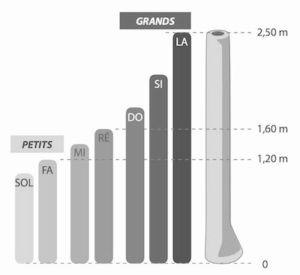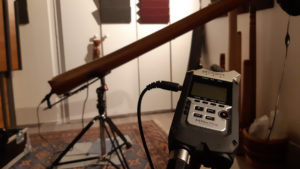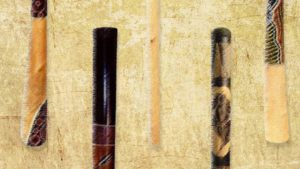This article is an automatic translation, it will be proofread and corrected by a “human” translator. If you want to help translate Wakademy, feel free to contact me!
A didgeridoo is like a human being, it has its own character! It can be head up or downright heavy. All players will tell you, a didgeridoo is unique. So what defines the character of a didgeridoo? And how do you know if it’s the right fit for your game? To help you better understand, here are the 4 major criteria that govern the “psychology” of a didgeridoo! These 4 major families are each subdivided into two extremes, thus forming pairs. Each of these opposites will have their pros and cons. By understanding them, you will be able to better choose a didgeridoo and especially to get to know it. Because a good didgeridoo is above all a didgeridoo whose personality resonates with yours.
1. First, the general shape of the didgeridoo
We can summarize a didgeridoo with two major shapes: conical and cylindrical.
Most of the time, a didgeridoo is a mixture of these two criteria. It is quite amusing to notice that these two forms are distinctly represented among the Aborigines, by the Yidaki (conical) and the Mago (cylindrical), offering two completely different styles (see also: The origins of the didgeridoo: the Aborigines of Australia ).
The conical didgeridoo: dynamic and powerful
 Here, imagine a very dynamic fellow. Indeed, its air column offers a lot of pressure which develops a large sound volume. They are very suitable didgeridoos for playing in the street for example, big mouths *** what. Tongue attacks are very easy to play, as the pressure provides great resistance. The sound has a unidirectional tendency. We often have the feeling with this form that the vibration is projected straight ahead.
Here, imagine a very dynamic fellow. Indeed, its air column offers a lot of pressure which develops a large sound volume. They are very suitable didgeridoos for playing in the street for example, big mouths *** what. Tongue attacks are very easy to play, as the pressure provides great resistance. The sound has a unidirectional tendency. We often have the feeling with this form that the vibration is projected straight ahead.
Finally, all the techniques that play with pressure (under-vibration and over-vibration) will be logically easy to play.
However, a too conical didgeridoo will sound aggressive, much too tense, here we are clearly with a nervous guy! Typically, this is not the didgeridoo for relaxation!
The harmonics will be as cramped, locked up. The bass will be stuffy, even tiring. It takes up too much space. As if it locked the sound in an enclosed space. Finally, the cheek techniques will be difficult to play due to lack of space in the air column.
The cylindrical didgeridoo: supple and full of softness
 If the conical shape develops dynamism, the cylindrical shape brings softness. Imagine someone gentle and quiet. The sound is round, enveloping. You will understand, this type of didgeridoo is more inclined to meditation. Playing techniques are easy to develop. The bass is enveloping. The vibrations seem to fill the room and the harmonics feel free to resonate as this configuration offers so much sweetness.
If the conical shape develops dynamism, the cylindrical shape brings softness. Imagine someone gentle and quiet. The sound is round, enveloping. You will understand, this type of didgeridoo is more inclined to meditation. Playing techniques are easy to develop. The bass is enveloping. The vibrations seem to fill the room and the harmonics feel free to resonate as this configuration offers so much sweetness.
However, as above, if this form is taken to the extreme the didgeridoo will lose playability. A bit as if our man was quiet on the sofa but difficult to motivate. It will therefore take a lot of energy to play all the joints (tongue, lips, etc.). In addition, the under-vibrations and over-vibrations will be difficult to pass.
Finally, the sound volume will be quite limited and the sound will not seem to flourish. Our guy speaks quietly, his voice is not projected.
2. Next, the size of the didgeridoo
 The length of a didgeridoo greatly influences its acoustics. To fully understand what this criterion brings, we will start from two extremes: small and large. Often times, a classic didgeridoo is an average of these two factors. Thus, most didgeridoos are between 1m40 and 1m80 in height. Understand that for the same given shape (conical or cylindrical), the longer a didgeridoo will be, the more serious it will be (A, B, C) and the shorter it will be, the more acute it will be (F, G).
The length of a didgeridoo greatly influences its acoustics. To fully understand what this criterion brings, we will start from two extremes: small and large. Often times, a classic didgeridoo is an average of these two factors. Thus, most didgeridoos are between 1m40 and 1m80 in height. Understand that for the same given shape (conical or cylindrical), the longer a didgeridoo will be, the more serious it will be (A, B, C) and the shorter it will be, the more acute it will be (F, G).
Long didgeridoo: seriousness above all (beyond 2 meters)
Here, our friend has a facility for talking about “serious” and serious matters. Its length gives it a deep sound. So deep that one can easily take the image of a cave. You are no longer on earth, but underground. A long didgeridoo will have very interesting resonance effects with tongue attacks. It will also offer a lot of ease to games related to pressure (over-vibration and under-vibration).
Nevertheless, this type of instrument can quickly become dark, going so far as to give off a dismal atmosphere. Our character imbued with depth can veer into heavy gravity. As the length increases, the note of the instrument becomes lower and lower, which does not help.
However, playing a song on stage with a long didgeridoo is often the most beautiful effect. The range of the sound is so different that it creates a nice contrast.
Didgeridoo court: joy of living! (below 1m40)
We have here a little man full of joy with a clear and light speech. Its harmonics will often be clear and singing, its vibration light. Its short size limits the muffled appearance of the bass and thus allows clear sounds to shine easily.
On the other hand, if it is too short it will fall into superficiality. The lightness of his words will eventually take up too much space and cruelly reduce its depth. Something will simply be missing and you will almost certainly want to go for some length.
3. The opening of the didgeridoo’s air column: opening to the world
 This criterion is particularly close to my heart! However, I prefer to warn you, I might not be completely neutral in this matter. May you forgive my strong positions. But I promise I’ll do my best to remain a diplomat!
This criterion is particularly close to my heart! However, I prefer to warn you, I might not be completely neutral in this matter. May you forgive my strong positions. But I promise I’ll do my best to remain a diplomat!
To summarize this personality trait, we will have two possible bore sizes. Added to this is a third diameter, which is the balance between these two extremes. These three dimensions are intimately linked with the shape of the didgeridoo (conical / cylindrical). Note also that when I speak of the diameter of the bore it is indeed the beginning of the internal air column of the didgeridoo. This is the size once the mouthpiece is removed, the real departure of the air column.
Small bore: a precise language (less than 35mm)
Here, the didgeridoo is very thin and his voice is precise. Its ease of play gives it a lot of charm.
Everyone is sensitive to charm.
It is therefore logical that we find this type of instrument everywhere. As much to tell you right away, I am not a big fan of this easy charm.
And this for two reasons :
- The first is that a didgeridoo starting at this size is at great risk of having a purely conical shape. It will therefore be necessary to be very vigilant to the weak points mentioned above: the nervous one can quickly bring it back!
- The second is that sound can quickly be locked up and not resonate. The vibration is locked up. Our man has a nasal voice, far from the pretty singing voices.
Except in France, this opening size is the standard in the world. Truth be told, other than the charm of its ease of play, I don’t really understand why. Another explanation would be that these didgeridoos are often powerful due to their conical shape …
Well… I’m still going to put a little water in my wine …
Rest assured some manufacturers still manage to create quality instruments with this type of openness ……….
… .. But still I do not like them… hum after reflection I did not put much water in the bucket…! In short, I still have a long way to go on the road to universal love.
Average breaks through: the golden mean? (36mm to 45mm)
NB: I start at 36 mm to give you an idea, this being that is only a very subjective approximation.
We are already in a more open didgeridoo. Here, it already sings significantly more than its predecessor and the sound is much more balanced. For my part, I hardly play a didgeridoo below 40 or 42 mm opening, the minimum.
At this point, the didgeridoo still retains pressure and playability while still being resonant. We start to have a shape inspired by the cylinder while remaining in the conical. This is in my opinion the most balanced opening size. It sits between the two extremes. And as the Buddha said so well: follow the middle path.
Large bore: from opening to dispersion (45 mm and more)
In this case, be sure, you have in front of you a big cushy! It is wide and the least we can say is that it can be seen and heard. The air column is more difficult to vibrate due to its imposing volume. The cheeks are happy to do what they want, the throat attacks too, just like the harmonics.
However, the shape is largely inspired by the cylinder with all the risks that this implies. Where a didgeridoo with a small bore will be enclosing, a didgeridoo that is too open will run the risk of being too “dispersed”. The sound no longer holds, the bass becomes muffled and can even drown out the sound.
However, if this kind of instrument is well balanced, it becomes incredibly smooth (cylindrical). It is certainly the most difficult category to play, but in my opinion the most melodic. Moreover, neophytes often fall in love with this kind of sound. I have a didgeridoo of this type with a 50mm bore, it is one of my best instruments.
4. The weight of the instrument: an often overlooked factor
 The weight of a didgeridoo stems from two factors. On the one hand the density of the material used and on the other hand the thickness of its walls. You can therefore have a didgeridoo with thin walls, but with dense wood which will be the equivalent of a didgeridoo with generous thickness, the wood of which is very light. To simplify the article, I will talk about the thickness of the wood, not its density. Let’s say that in our example, our didgeridoo will have a medium density wood.
The weight of a didgeridoo stems from two factors. On the one hand the density of the material used and on the other hand the thickness of its walls. You can therefore have a didgeridoo with thin walls, but with dense wood which will be the equivalent of a didgeridoo with generous thickness, the wood of which is very light. To simplify the article, I will talk about the thickness of the wood, not its density. Let’s say that in our example, our didgeridoo will have a medium density wood.
Thin walls: an aerial didgeridoo
Thin walls will bring a very light didgeridoo. His company is very pleasant, we can do whatever we want with it! The advantage is that first of all your didgeridoo will be… light! It’s silly to say, but it’s important to take into account. Both in terms of transport and when you hold your didgeridoo while playing. Lightness is a real plus in terms of comfort. In addition, if it is light to support, it will also have the advantage of being light to play. By that I mean that the sound will be airy and therefore very easy to handle. If you want to walk or fly, it is possible.
However, a didgeridoo that is too light can be far too ethereal and its bass will suffer. The note will be unstable and the low frequencies will be sorely lacking in density. Basically, your guy will risk not having his feet on the ground and will have his head in the stars.
Thick-walled: an earthly didgeridoo
In this case, we will have a heavy didgeridoo, at least of a certain weight. Its big advantage, unlike the light didgeridoo, will be the density of its bass. This one is definitely anchored on earth! Its bass will often be of good quality and the sound of foolproof stability.
On the other hand and always in the same principle, too much weight will nail it to the ground. No need to try to reach the heights of heavenly songs. Your didgeridoo will be heavy to carry and play. As much the light didgeridoo will be a kite, here you will have a real heavy weight. It’s like walking a dirt road with boots on after the rain has fallen. Can you smell the earth? Well, that’s exactly it with too heavy didgeridoo. It is heavy!
Reconcile these criteria to find the right balance

Of course, this short presentation of the various personalities of our old friend is far from exhaustive. You will understand that one shape is not better than another (apart from the small diameters! ?).
Just like each of our personality traits, the whole is coherent and complements each other perfectly. The art of making a didgeridoo will be to find the right balance between these polarities. The goal is to create an instrument as close as possible to the desired style and not too neurotic if possible!
• • •
“The truth is the point of equilibrium of two contradictions.”
Chinese proverb
• • •
Remember: our role is to let it express itself (see also:What your didgeridoo will teach you, if you learn to listen to it! ). We just have to listen to it. Each didgeridoo carries its own rhythms and sounds. And with a little practice, you will find that ten seconds is more than enough to determine the character of the individual!
The important thing as a player will be to integrate these different indications, in short to study the morpho-psychology of the didgeridoo. Indeed, the classic trap is to hope for THE perfect didgeridoo that would reconcile all these opposites. He would then be disconnected from any physical reality. You would ask the impossible of the didgeridoo maker.
As if you were hoping for THE perfect companion for your life. You may be looking for a long time. (Although perfection is subject to many very objective criteria, but that’s another debate!)
Conclusion: manufacturer and player, complementary work
In my opinion, the goal of practicing the didgeridoo boils down to discovering yourself through your instrument. If you know what you like to play, if you are in tune with your instrument, then it will be possible for you to grab the didgeridoo that is made for you. Because you will know which character suits you best.
The manufacturer, meanwhile, is working on his physical knowledge of the instrument (see also:5 top-of-the-range didgeridoo crafter you should know ). He must go in search of the secret cogs which govern the acoustics and the playability of a didgeridoo.
So the maker shapes the body and the player blows the mind.
And this teamwork brings the music to life.
Did you like this article ? So if you could help me make it known, that would be great fun! Share it without counting. 🙂 And if you have criteria to add, post them in the comments, it will help more than one player!
Source of illustrations:
Stephane Bouillet , taken from the “ Didgeridoo method “that I wrote.












